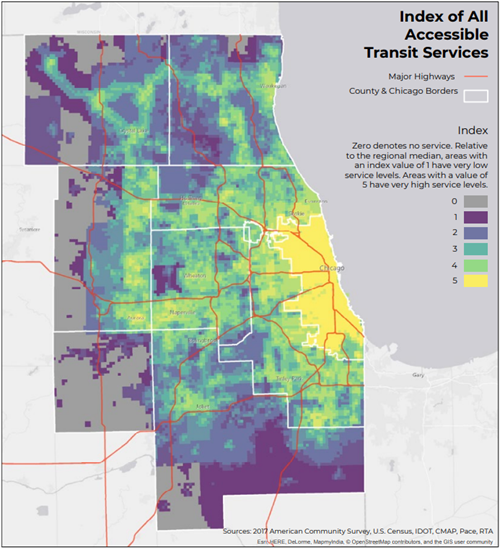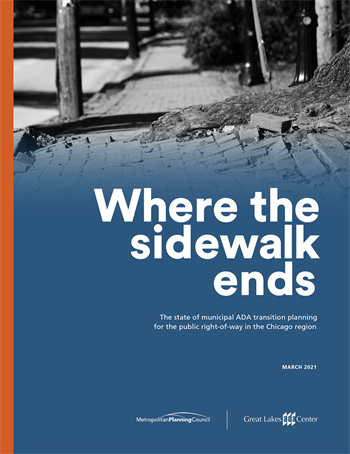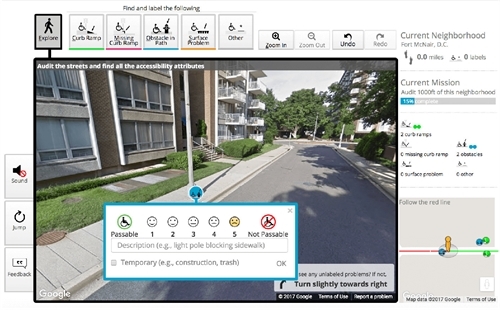How Far Have We Moved Toward Universal Mobility?
It’s been two years since MPC released Toward Universal Mobility. We’ve made a lot of progress toward creating a transportation system that works for everybody, regardless of age or ability. But much work remains.
For able-bodied people, we take a lot about our mobility for granted. But we will all be impacted by disability at some point in our life. How would you get around if you developed a mobility disorder and couldn’t drive? How would you take care of your daily needs if you broke your leg? What will the quality of life be for your parents or grandparents when they give up their license?
In recent years there has been increasing understanding of the need to develop a transportation system that works for everyone – with particular recognition of the significant improvements needed to serve people with disabilities and those who can’t drive. Despite the Americans with Disabilities Act (ADA) being passed 31 years ago, our transportation system is all too often a patchwork of obstacles. Adhering to ADA requirements is the bare minimum we should be doing – and in many cases, we aren’t even doing that.
In December 2019, MPC released Toward Universal Mobility: Charting a Path to Improve Transportation Accessibility. The report was the culmination of more than a year of research, interview, and focus groups, and made 32 recommendations to improve mobility for people with disabilities and seniors.
Little did we know that the report release would be one of MPC’s last in-person events before quarantine began. And as the COVID-19 pandemic ground our world to a halt, it also further entrenched existing disparities. This is especially true for people with disabilities. Two years later, Toward Universal Mobility feels more important than ever, so we wanted to take stock of the progress made toward implementing its important recommendations. Below are highlights of where significant progress has been made.
Establish a Regional Mobility Coordinator

During the development of Toward Universal Mobility, MPC worked with a student team at the University of Chicago’s Harris School to create an index of all accessible transit services in the seven-county Chicago region. It revealed a very uneven level of service. Two municipalities or townships that may be geographically close might have very different mobility options. To better identify gaps, align services, facilitate collaboration, and create a seamless service experience, the report’s top recommendation was to establish a network of regional mobility coordinators. Each county would establish at least one mobility coordinator and all of them would work with a single mobility coordinator that would establish consistency across the entire region.
Paratransit is most often a shared, flexible-route public transportation service for people who are unable to ride traditional fixed-route transit (like buses and trains) due to a disability.
Over the past year, the Regional Transportation Authority (RTA) has undertaken a study to document how a mobility coordinator network could help solve known problems for the region’s many paratransit service providers. The study to be released in early 2022 will recommend how such a network could be structured, and where it could be housed. RTA also encouraged counties to submit proposals for federal 5310 funding that include mobility coordinator roles. Kane County took them up on the offer and received support to expand their Ride in Kane paratransit service and hire a full-time mobility coordinator.
Create a technical assistance program to develop ADA Transition Plans

An ADA transition plan is a federally-required plan that documents barriers to access in the public right-of-way (i.e. sidewalks and crosswalks) and establishes a schedule for when and how those barriers will be removed. These plans were supposed to be completed by most municipalities within a few years after the Americans with Disabilities Act was passed in 1990. Fast forward three decades later, and we know compliance is shockingly low. In fact, MPC wrote an entire report on this very subject: Where the Sidewalk Ends. We found that only 11% of municipalities in the greater Chicago region could show compliance with this important civil rights legislation.
Our report generated a lot of interest, and we were especially excited when the Chicago office of the Federal Highway Administration asked us to join with the Chicago Metropolitan Agency for Planning (CMAP) and the Illinois Department of Transportation (IDOT) to discuss how this problem might be solved. CMAP is currently in the process of staffing up a new division that will be focused exclusively on Title II compliance (which includes transition plans) and is in the early stages of creating a technical assistance program to help municipalities create these important guiding documents.
Pilot a subsidized ride-hailing service to complement ADA paratransit
ADA paratransit is an irreplaceable, critical service for people with disabilities. But not every trip requires a dedicated paratransit vehicle. In some cases, the needs of the rider can be met more quickly with more flexibility by ride-hail companies like Uber or Lyft. Some peer regions have had great success in offering subsidized rideshare rides to paratransit users, and our report recommended the Chicago region establish a pilot program to explore how it could work here. The RTA’s paratransit innovation study, published in February 2021, came to a similar conclusion. It’s expected that Pace, the region’s ADA paratransit provider, will be procuring a contract later this year.
Assemble regional data on pedestrian infrastructure, and crowdsource data to improve wayfinding
Many of our report’s recommendations focused on improving the data and tools that people use to make travel decisions, and that policymakers use to set priorities or make investments. Drivers have an incredible amount of real-time information at their disposal: live traffic, lane closures, and very detailed street maps. By comparison, pedestrians have almost no information to plan their route. Will there be a curb ramp at every corner on your route? Are pedestrian signals present? Will there even be a sidewalk? CMAP began to chip away at this problem by creating the region’s first comprehensive sidewalk inventory in 2018. It was a painstaking, manual process that produced a valuable but relatively simple dataset.

A screenshot of the Project Sidewalk user interface.
To collect comprehensive data on pedestrian accessibility, you either need a lot of people or a lot of time. One way to make the process more effective is to use crowdsourcing. MPC was excited to support our research partners at UIC’s Department of Disability and Human Development as they pursued (and won!) a National Science Foundation grant to build a platform to allow anybody with an internet connection to scout the streets of Chicago via Google Street View to document accessibility barriers. The base platform is called Project Sidewalk and is already live in a number of North American cities, including Seattle, Columbus, and Mexico City. This data will be useful to anybody who relies on pedestrian infrastructure to get around – which is all of us.
Eliminate IDOT’s local financial match requirement for sidewalk construction
Until recently, IDOT required local municipalities to provide 20% matching funds for any sidewalk construction along an IDOT road. In many communities, these state-owned roads are the “main drag” through town. They’re often quite car-oriented and dangerous for pedestrians and wheelchair users. Being both destination-rich and pedestrian infrastructure-poor also makes them exclusionary for people who can’t or choose not to drive. The 20% match made it less likely that sidewalks would be included on IDOT projects, especially in lower-income communities. But thanks to advocacy by the Active Transportation Alliance, Ride Illinois, MPC, and others, the Illinois legislature passed HB270, which eliminated the local match requirement.
Prioritize funding for universal accessibility of all regional rail stations
The Chicago region is lucky to have such an expansive network of rapid rail transit. But as a legacy system largely built in the 19th and early 20th centuries, much of it is inaccessible for people with disabilities. MPC was proud to lend our voice to Access Living and other advocates to get the All Stations Accessibility Program (ASAP) Act of 2021 included in the federal Bipartisan Infrastructure Law. This act created a new program to help legacy rail systems like CTA and Metra bring all their stations into full compliance with the ADA.
Enact housing policies that encourage accessible housing near fixed-route transit
Transit is only useful if you live close enough to use it. For people with disabilities, that means being able to find accessible and affordable housing in areas that are often in high demand. MPC was a key stakeholder in the City of Chicago’s Equitable Transit-Oriented Development (eTOD) workgroup that developed the eTOD Policy Plan adopted in June 2021. This plan will help the city revise its rules and regulations to incentivize and/or require the development of accessible and affordable housing near transit.
But this isn’t just a problem in Chicago. As part of MPC’s efforts to help the Metropolitan Mayors Caucus implement the Climate Action Plan for the Chicago Region, we’re hosting an event in 2022 to share success stories and best practices for eTOD in suburban Chicago.
What’s next?
Despite the progress we’ve made since December 2019, there’s still much work to be done. Fortunately, our region is more aligned than ever. RTA’s Human Services Transportation Plan from March 2021 echoes many of the recommendations made in Toward Universal Mobility and serves as an excellent framework for how advocates, riders, and public agencies can work together to create an inclusive and equitable 21st-century transportation system. We need to keep up the momentum to get more strategies implemented – please join us!
